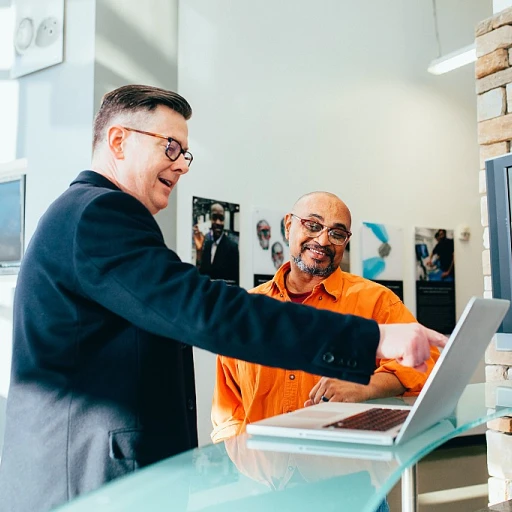
Understanding the Enterprise Mindset
Defining a New Paradigm
As the tides of the global business landscape continue to shift, organizations must cultivate an enterprise mindset to navigate this complex era. This mindset isn't merely a collection of thought processes; it embodies a strategic approach that fundamentally transforms how we perceive and conduct work across the entire organization. Such a shift is crucial as we prepare for the challenges and opportunities technology continues to present.
Adopting this mindset involves key practices that shape enterprise leadership. Leaders must integrate comprehensive thinking strategies, enabling their teams to adapt fluidly to evolving circumstances. This adaptability is rooted in a commitment to continuous learning and a proactive stance toward technological advances.
The Intersection of Enterprise Thinking and Collaboration
Effective enterprise leaders recognize that fostering a culture of collaboration is integral to this mindset. By embracing diverse perspectives and encouraging a flexible work environment, they empower their teams to engage more dynamically with challenges. This collaboration extends across all business functions, ensuring that decisions are made with a holistic view.
Moreover, a robust enterprise mindset empowers decision-making processes. Decisions are made in the context of long-term objectives, aligning with both organizational goals and the anticipated impact of technological shifts. This forward-thinking approach is essential for talent management, enabling the identification and nurturing of high-potential individuals.
Organizations must also equip their leaders with the necessary skills to embody this mindset. Programs from recognized institutions such as Harvard Business School can offer valuable insights into developing such capabilities, positioning leaders to impact both their immediate teams and the larger business ecosystem.
In conclusion, cultivating an enterprise mindset is not just about understanding these concepts but applying them pragmatically within the organizational context. This includes evolving in line with advancements and nurturing a culture that prioritizes continuous learning.
Adapting to Technological Advances
In today’s rapidly evolving business landscape, embracing technological advances is critical for an enterprise striving to maintain a competitive edge. The workplace is constantly being reshaped by a variety of technological innovations, fundamentally changing how organizations operate and how leaders engage with their teams.
Unlocking Technological Potential
Technology presents unparalleled opportunities for businesses to streamline processes and boost productivity. Enterprises must harness digital tools and systems effectively to improve efficiency across various business functions. This requires leaders committed to enterprise thinking and capable of identifying the technologies that align with the company’s strategic goals.
Encouraging innovation through strategic technology adoption can facilitate enterprise growth and contribute to long-term success. Embracing new technologies can also attract high-potential talent, eager to engage with cutting-edge solutions and drive the organization forward.
Enterprise Leaders Guiding the Charge
Enterprise leadership, at its core, involves guiding organizations through technological shifts with a clear vision. Leaders need to possess the skills to evaluate technologies not just for efficiency but also for their impact on the entire organization. Decision-making grounded in a solid understanding of technological trends and potential business impacts will determine future success.
Successful leaders not only invest in technology but also nurture an adaptable mindset within their teams. They encourage their teams to explore new technologies, develop digital skills, and consider innovative ways to integrate these into the organization’s operations, ensuring that the enterprise remains agile in the face of change.
Challenges and Considerations
However, adapting to technological advances isn’t without its challenges. Privacy policy changes and data security concerns necessitate caution and strategic planning. Leaders must ensure that any technological shifts align with compliance requirements and safeguard the organization’s reputation and data integrity.
Furthermore, fostering a leadership mindset that values ongoing learning and flexibility becomes imperative as technology continues to evolve. Leaders must be proactive in addressing potential obstacles to technological adoption, thus enabling their teams to navigate the complexities of the digital era.
By leveraging technology judiciously, enterprises can unlock new levels of efficiency and innovation, ensuring alignment with the strategic objectives of the business. Adapting to technological advances is not just a requirement but a crucial aspect of maintaining a forward-thinking enterprise mindset.
Fostering a Culture of Continuous Learning
Embrace a Learning Culture for Adaptable Success
In the face of rapidly changing work environments, fostering a culture of continuous learning within your organization is paramount. Businesses that prioritize talent development and lifelong learning are better positioned to stay competitive. This enterprise mindset ensures teams can readily adapt to new technologies and evolving business functions. Learning should not be viewed as a one-time training session but as an ongoing process integral to the organization's fabric. Encouraging your team to continuously upgrade its knowledge base and acquire new skills can lead to high potential individuals rising through the ranks. For this to happen, enterprise leaders must allocate resources towards continuous learning initiatives that foster adaptability and innovation. This involves not only providing access to educational materials and opportunities but also cultivating an environment where learning is appreciated and valued.A practical approach to implementing a culture of continuous learning includes:
- Tailored Professional Development: Customize training programs that align with the needs of various business functions and individual career aspirations.
- Platforms for Knowledge Sharing: Establish forums or digital platforms where employees can share insights and experiences, promoting enterprise thinking across the board.
- Mentorship Programs: Consider exploring key mentoring topics to support the growth of potential leaders within the organization.
- Real-World Applications: Encourage learners to apply what they've learned to their current roles, thereby ingrain new skills and boost decision making confidence.
Encouraging Collaboration and Flexibility
Building a Collaborative and Flexible Environment
In a landscape where adaptability and innovation are crucial, fostering collaboration and flexibility within an enterprise is not just beneficial but necessary. Successful companies recognize that the ability to work effectively as a team and to pivot quickly in response to changing circumstances can greatly enhance their competitive edge. Creating a collaborative environment begins with establishing clear communication channels. Effective communication allows business leaders to disseminate information swiftly and accurately across the entire organization. In turn, it empowers employees to contribute their unique insights and skills, refining enterprise thinking and enhancing decision making processes. Moreover, flexibility in work arrangements is becoming an increasingly important aspect of enterprise mindset. By incorporating flexible work policies, such as adjustable hours or hybrid working models, companies can better accommodate diverse employee needs. This approach not only supports work-life balance but also helps to retain top talent and maximize productivity through increased focus and employee satisfaction. Every enterprise can benefit from adopting tools and technologies that streamline collaboration. Digital platforms and cloud-based services can facilitate seamless communication and project management, allowing teams to work together efficiently even when physically apart. Integrating these technologies into business functions optimizes long-term outcomes and future-proof solutions. Ultimately, the impact of nurturing a culture that prioritizes both collaboration and flexibility is profound. It enhances a company's ability to innovate and respond to the evolving needs of the market. By investing in these aspects, organizations are better positioned to develop leadership skills needed to thrive in the future of work. Enterprise leaders set the tone for such an environment by modeling collaborative behavior and prioritizing flexibility in their leadership mindset. As organizations continue to adapt to technological advances, fostering an enterprise mindset that embraces these principles will be crucial to remaining at the forefront of their industry.Balancing Remote and In-Office Work
Integrating Remote and In-Person Work Models
The enterprise mindset requires flexibility and innovation in approaches to where and how work is done. Companies are increasingly recognizing the impact of flexible work arrangements on productivity and employee satisfaction. Thus, blending remote and in-office work has become a significant trend. For business leaders, developing successful hybrid work strategies involves more than just logistics. Instead, it requires shifts in enterprise thinking that embrace change and adaptability across the entire organization. Balancing remote and in-office work isn't about choosing one over the other; it's about fostering an environment where both can coexist effectively and efficiently. Some key considerations for companies include:- Team Cohesion and Collaboration: Encouraging collaboration despite physical distance is crucial. Companies must leverage technology that supports seamless communication and teamwork, such as video conferences and project management tools. This adaptability can enhance decision making, driving forward business functions in a more integrated manner.
- Privacy and Security: With more people working remotely, maintaining privacy and security becomes paramount. Leaders need to ensure that robust privacy policies are in place to protect both the company and its employees.
- Management and Leadership: Enterprise leaders have a responsibility to champion these new work models. Leadership mindset plays a critical role in balancing these dynamics, ensuring that all team members feel valued and engaged regardless of their location.
- Talent Assessment: Organizations should also focus on talent management strategies that identify high potential leaders who can thrive in remote and hybrid settings. Enterprises benefit when they align these skills with long-term goals, ensuring that their organization's needs are met both in the present and the future.












